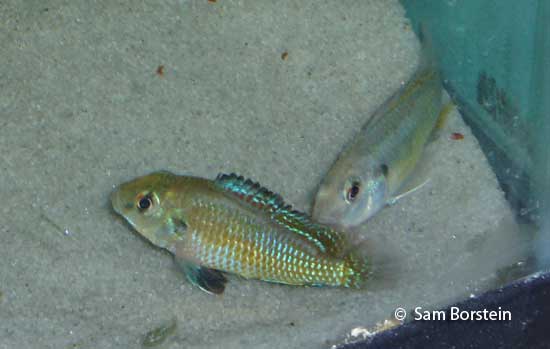Pseudocrenilabrus multicolor multicolor
(Schoeller, 1903)
Egyptian Mouthbrooder
Above: A male Egyptian Mouthbrooder spawning. Photos by Sam Borstein.
Etymology:
Genus- Pseudo=fake (Greek), crenilabrus= cut lip (Latin).
Species- multicolor= many colored (Latin).
Subspecies- multicolor= many colored (Latin).
Intro:
Pseudocrenilabrus multicolor multicolor is one of the first West Africans to really be popular in the hobby. This fish, known as the Egyptian Mouthbrooder, was one of the first readily available cichlids. This fish gets its nickname from the area of which it is found, Egypt.
There are 2 sub-species of Pseudocrenilabrus multicolor:
- Pseudocrenilabrus multicolor multicolor- found in Egypt and Sudan. This is the one known as the Egyptian Mouthbrooder.
- Pseudocrenilabrus multicolor victoriae- found in the Lake Victoria Basin.
Pseudocrenilabrus multicolor victoriae can be differentiated from Pseudocrenilabrus multicolor multicolor by body color, the presence of blue lips, black edging to the dorsal fin with a red band underneath, and a red dot at the tip of the anal fin in males.
Pseudocrenilabrus is a genus that needs a revision and it would not be surprising to see the two sub-species given full species status in the future (Lamboj, 2004).
Distribution:
Egyptian Mouthbrooders are found in creeks and pools in Egypt and Sudan.
Size, Maturity, and Sexual Dimorphism:
Size: Males- 4 inches, Females- 3 inches
Maturity: 1 inch
Sexual Dimorphism: Males are larger than females and are a lot more colorful than the females which are silver.
Care:
Although this is a small fish, they are super aggressive. Be sure to keep them in groups, otherwise the male will pick of females. It is good to have extra males, as the dominant male will go after them more than he will the females, keeping the females in better condition and less stressed. These fish are tollerant of many types of water and I've had luck in the past mixing them in larger tanks (4 foot+) with rift lake cichlids. More robust mbuna and Malawi haplochromines make excellent tankmates.
Diet:
This fish is not picky. In the wild they feed on insects and snails, but it will eat anything in captivity.
Breeding:
Egyptian Mouthbrooders are pretty easy to breed if you get the females in condition and stress free. They spawn like a Victorian Hap would in a standard T position spawning. Prior to spawning males stake out a territory and dig a pit in which spawning takes place.

Above: Egyptian Mouthbrooder spawning sequence. Photos by Sam Borstein.
Females are good holders, even at an inch long. The term for all Pseudocrenilabrus is short, 12-14 days. The eggs are small. When my 1 inch fish spawned, I got 6 eggs. From my 3 inch fish, I got 35, so number of eggs is related to age and size.
fry are really small, but easy to raise on baby brine shrimp. At 1/2 and inch, the fry start to color up. Fry grow relatively quickly and by 2-3 months are easily an inch long.
Conclusion:
Pseudocrenilabrus multicolor multicolor is a nice fish. It is not as spectacularly colored as the Pseudocrenilabrus nicholsi, but is still nice. It is highly aggressive though. I recommend all Pseudocrenilabrus for mbuna lovers, as I think they will like the color and the aggressiveness. Also, it's a good pick if you like Victorians. This species is rarely available in pet shops and goes through periods of popularity in the hobby, which can make it difficult to get. This makes a good species for someone looking to get into West African cichlids, especially if they have experience with rift lake cichlids.
References:
- Lamboj, A. (2004). The Cichlid Fishes of Western Africa. Bergit Schmettkamp Verlag, Bornheim, Germany, 255 pp.
